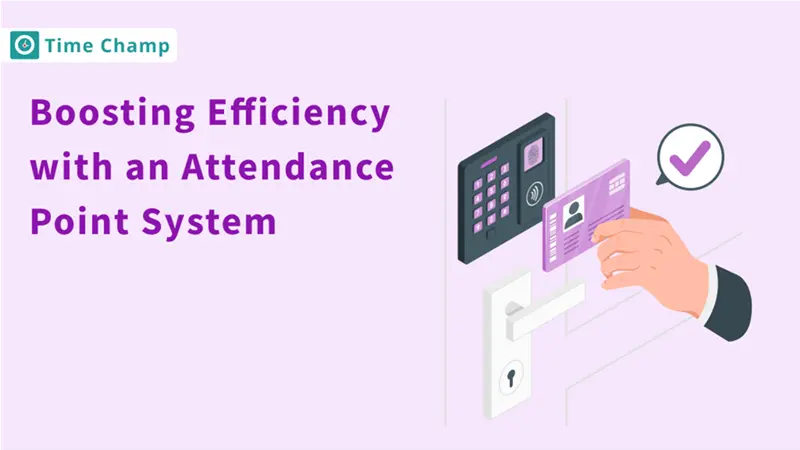Managing the employee attendance becomes hard to handle when there is no clear and standard way to do it. The attendance point system gives an organized method to track employee absences, late arrivals, and early leaves. It helps improve responsibility in the organization while boosting team productivity and ensuring fair rules for all teams.
In this blog, you will discover what an Attendance Point System is, how it works, and why top companies rely on it to manage attendance fairly and boost productivity.
What is an Attendance Point System?
The attendance point system helps businesses to easily monitor employee absence patterns, as well as when they arrive late or leave early. Workers receive points according to the system whenever they miss a shift. Those who get many points may receive either a warning or a minor disciplinary action. The system ensures fairness and improves team performance in organizations.
Key Objectives of the Attendance Point System
Here are the objectives that helps with keeping records of attendance, motivating people to arrive on time and making everyone responsible at their workplace.
Promote the Workplace Accountability
The attendance point system helps to build a responsible and disciplined work culture by:
-
Encouraging employees to be on time and present consistently.
-
Sets clear expectations about attendance behavior.
-
Promotes fairness by applying rules equally to everyone.
-
It helps to reduce the unplanned absences and tardiness.
Standardized Disciplinary Action
Standardized disciplinary action means applying the same rules and outcomes to all employees when it comes to attendance. Here is how:
-
Makes sure all employees are treated in a fair way
-
Helps everyone know the rules and what happens if they’re broken.
-
Builds trust that the company is being fair with everyone.
Support HR and Management Decisions
Having clear and accurate attendance records helps HR and managers make better decisions. It ensures fairness, supports planning, and improves how the team is managed.
Here’s how it helps:
-
The system gives HR teams and managers clear records about employee attendance.
-
It helps managers make the right decisions about employee rewards and warnings.
-
The system helps remove confusion and wrong decisions about employee attendance issues.
How the Attendance Point System Works
Here’s how the attendance point system works:
Point Allocation for Attendance Violations
Each violation of the attendance rules is given a certain number of points by the system. They are used to observe and measure the absenteeism of the employee.
Here’s the example point allocation system:
-
Late by a few minutes (under 15 mins): 0.5 point
-
Late by 15 minutes or more: 1 point
-
Leaving work early without notice: 1 point
-
No-show without calling in: 2 points
-
Absent without a valid reason: 1.5 points
Tracking Attendance Events
Organizations use the attendance point system to track three types of employee attendance issues: late and early leaving, shift absence, and time record failures. Each of these is called an “Attendance Event”.
Thresholds and Escalation
Employees receive points through an attendance system when they miss work or arrive late. The company implements actions when employees accumulate a specific number of points.
For example:
At 3 points, the employee might get a reminder.
At 6 points, a warning could be issued.
At 9 points, a formal meeting or action may take place.
The system enables the organization to detect early warning signs while motivating all staff members to maintain their performance levels.
Reset and Reduction Policies
The purpose of reduction policies is to help employees reduce or clear their attendance points as time goes on. They allow employees to improve their attendance without facing serious consequences.
For example:
-
Point reduction might happen when an employee has perfect attendance for a certain number of days or weeks.
-
A point reset could occur after a specific period, like every 6 or 12 months, where all points are cleared if the employee has shown improvement.
The main goal is to motivate employees to improve their attendance by offering a second chance to clear or lower their points over time.
Employee Communication and Access
Employee communication and access in an attendance point system helps employees always know how their attendance looks and clearly understand the rules.
Here’s why it matters:
-
Employees can quickly check how many attendance points they have at any time.
-
Clear rules helps the employees in avoiding confusion.
-
Helps the employees to take responsibility for improving their attendance.
Benefits of a Well-Designed Attendance Point System
Here are the advantages of having a well-organized attendance point system:
Promotes Consistent Attendance
A proper attendance point system encourages regular attendance by setting clear rules and consequences. People are more likely to attend work regularly when their attendance affects their points or performance. The system rewards being on time right away and gives consequences to those who miss work, which motivates employees to attend more often.
Ensures Fairness and Transparency
A properly designed attendance point system uses the same rules for everyone to make sure each person is treated equally. Decisions are taken based on collected employee data and lower the chance of favoritism and unfair treatment. The system gives clear rules about rewards and outcomes based on the behavior, which helps create open and understandable conditions. It keeps regular records of attendance, which helps in judging progress fairly and fixing problems easily.
Improves Team Productivity
The regular presence of the team members creates a better workflow which enables tasks to be completed on time. Team members who present themselves at every scheduled shift enable projects to move consistently without any disturbance. The absence of employees leads people to carry out only their standard responsibilities by preventing workload and stress. It creates an environment that promotes open sharing of thoughts and ideas during meetings. Regular attendance creates a stronger team that produces better organizational performance.
Try Time Champ to manage tasks, track time, and boost team productivity, all in one place!
Signup for FreeBook DemoIdentifies Attendance Issues Early
The attendance point system helps quickly find attendance problems when they begin. It notices when someone is often late or absent early on. Finding the problem early allows the managers to talk to the person and understand what kind of help they might need. Taking action early before it happens stops bigger problems from happening and gives the employees a better chance to improve their attendance at the workplace.
Core Components of an Effective System

Here are some of the main goals of the Attendance Point System, which helps in better tracking of attendance, staff discipline regarding punctuality, and overall responsibility in the workplace.
Clear Attendance Policy
The company should have easy-to-understand rules about when workers need to be at work.
A Clear attendance policy is of great benefit to both the employees and employers as they are able to stay on the same page. It tells of things such as when to clock in, how to take time off, what is late or absent, and what happens when one breaks the rules. If the policy is clear, the confusion is minimal, there will be fewer conflicts and everybody knows what is expected. It also provides a uniform and fair way of handling attendance issues by managers.
Consistent Point Assignment
A well-made attendance point system gives points fairly to all staff members. The system gives certain point values to each attendance issue, like being late, leaving early, or missing work without permission. The point values should be the same no matter who the employee is or what job they have.
Automated Tracking Tools
These tools replace keeping track of attendance by hand. The organization implements three security technologies which include biometrics and authenticator apps like Microsoft and ID card swipe systems. The system gives points to employees based on when they come in, leave, or if they miss work without permission.
These systems save time, reduces the mistakes, and help both managers and employees understand their attendance clearly.
Want to simplify attendance tracking?
Try Time Champ for automated attendance and point tracking, accurate and easy.
Signup for FreeBook DemoEmployee Transparency
Employee transparency lets the workers to see how their attendance is tracked and how points are given for being late, leaving early, or missing work without permission.
When employees are able to check their attendance records and point totals anytime, they understand the system better and know where they stand. It also helps to reduce the confusion because employees can check their records any time instead of guessing or worrying.
It also makes it easier for employees to talk to their manager if something seems wrong.
Sample Attendance Point System Template
A. Purpose of This Policy
In our [company_name], we believe that teams work best when everyone is present and on time. If you arrive late or fail to show up at work, it can cause difficulties for those around you.
We are aware that workers may sometimes have trouble arriving at work on time. This section explains how employees should communicate their inability to work and what the consequences could be for those who do it frequently.
B. Tracking Attendance and Points
To make sure everyone is treated equally, we use an attendance points system. Points are awarded when the employees are late, absent early, or absent without notice to their supervisor.
Key Definitions & Point System:
| Type | Description | Points |
|---|---|---|
|
Early Departure
|
Leaving work more than 30 minutes before your shift ends
|
0.5
|
|
Tardy
|
Arriving 1–19 minutes late
|
1
|
|
Late Arrival
|
Arriving 20 minutes to 2 hours late
|
3
|
|
Unexcused
Absence
|
Absent for more than 3 hours without proper notice or approval
|
5
|
C. Clarification of Attendance Terms
Leaving the Job Too Early: Departing from work more than 30 minutes before you are supposed to.
Tardy: If an employee gets to work up to 19 minutes after their assigned time.
Late Arrival: If an employee arrives after being scheduled to be there up to 2 hours.
An employee is considered as an unexcused absence when they miss more than 3 hours of work or an entire day without informing their supervisor.
D. Disciplinary Steps Based on Points
Points are collected from every 12 months. The actions listed below will depend on the points an employee has:
| Total Points | Consequence |
|---|---|
|
10 points
|
Verbal warning
|
|
15 points
|
Written warning
|
|
20 points
|
Employment termination
|
Employees who are absent for three or more consecutive days must provide proof (e.g., doctor’s note or supporting documents) explaining the absence.
E. Notification Requirements
Everyone should alert their supervisor or department as early as possible if they are unable to attend work.
If the employee does not let you know, the following actions will take place:
| Occurrence | Action |
|---|---|
|
First failure to notify
|
Verbal warning
|
|
Second failure to notify
|
Written warning
|
|
Third failure to notify
|
Termination
|
Job Abandonment:
If an employee misses 3 or more consecutive days without any communication, it will be considered job abandonment. This will lead to termination on day 3, without prior notice.
F. Absences That Do Not Count Against You
Some absences are understandable and will not result in attendance points as long as they are properly communicated and supported with documentation when required. These include:
Death of a family member (bereavement)
Jury duty
Doctor or hospital appointments
Car accidents or emergency breakdowns
Childbirth or maternity-related leave
Military service
Severe weather that makes commuting unsafe
Time away from work included in FMLA (Family and Medical Leave Act).
Absences linked to disabilities listed in the ADA (Americans with Disabilities Act).
When Documentation Is Needed:
To avoid receiving points, some of the above absences may require proof. Please submit documentation at least two days in advance when possible, for:
Court service
Military duty
Leave for family loss
Planned personal time off or sick days will also be excused if you notify your manager or department before your scheduled shift begins. HR will then record it correctly in your attendance log.
Note: This policy is designed to give an example only and does not serve as legal advice. It is important to look into the rules in your area before implementing a formal attendance policy.
Best Practices for Implementation
Creating a successful attendance point system means making it easy to follow, equal for everyone, and simple to manage. Here are some practices that will help you to establish an effective attendance system:
Communicate the Policy Clearly
Every employee should learn about the attendance rules on their first day of work. The policy explains what it is and what happens if someone comes late or misses a day and how the point system works. The explanation should use simple words and clear examples so that everyone can understand it easily. These steps helps to avoid the confusion and make sure all employees are treated equally.
Train HR and Managers
HR staff and managers should be properly trained so they understand how the attendance point system works. This will help them:
Explain the rules clearly to the employees. Usage of tools like authenticator apps or scanners to track attendance the right way. Make sure that everyone are treated equally, no matter about their role. Know what steps has to be taken when someone is often late or absent.
Use Attendance Software
Using software to track attendance like the Time Champ makes the system easier and more accurate. It automatically records when the employees arrive and leave, assigning points for being late, leaving early, or not showing up. Time Champ makes it simple for HR and managers to track attendance records and ensures that everything is done fairly. By eliminating the manual tracking, it saves time and reduces errors. Additionally, employees can check their own attendance and points and giving them clear visibility into their status.
Review and Improve Regularly
The attendance system works well when it is checked regularly and updated when needed. Regular checks of the system must ensure fairness and easy comprehension for all users. The system needs employees and managers to talk about any problems and give ideas to help make it better.
The rules and tools should be changed when the system doesn’t work well or when the company makes changes. The point system needs to maintain its effectiveness as a tool for maintaining punctuality at work.
Conclusion
The attendance point system tracks the attendance and encourages being on time to make sure all employees are treated equally. The system helps the business to run smoothly by making sure the right people are at work and giving managers better information for making decisions. The system improves how well everyone works and creates an equal environment for all employees.
FAQs:
Traditional attendance tracking simply records when the employees are present or absent, without any clear results. An Attendance Point System assigns specific points for each attendance violation like being late or absent without notice. These points add up and lead to discipline when certain thresholds are reached. This makes the attendance management more structured, consistent, and equal across the organization.
Yes, employees should be allowed to appeal their attendance points if they believe there was an error. A fair system includes a process for the employees to review their records and provide supporting documents like medical notes or emergency proof. Such protocols establish trust with the system while providing equality to all individuals. Managers or HR should review the appeal and adjust points if necessary.
An employee who has a valid reason such as medical emergency or approved leave will not receive attendance points. The attendance policy should clearly define what counts as an excused absence. Staff need to tell their supervisor about their absence either before or right after it happens. Showing proof along with the documents helps avoid confusion and makes sure the system is used fairly.
Maintain straightforward and gentle rules for the group's operations. All team members must understand the rules while receiving fair treatment and employees should have the chance to explain any noticed problems. The application of transparency together with fairness produces excellent results.







